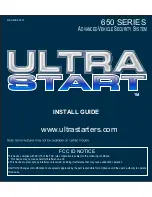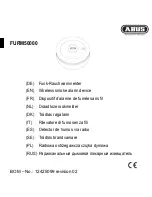
F300-27-00
1
I56-1975-004R
Fire•Lite Alarms, Inc., One Fire-Lite Place, Northford, CT 06472, 203-484-7161
Before installing detectors, please thoroughly read the NEMA
Guide for Proper Use of Smoke Detectors in Duct Applications,
which provides detailed
information on detector spacing, placement, zoning, wiring, and special applications. Copies of this manual are available from NEMA (National Electrical
Manufacturers Association, 2101 L Street NW, Washington, DC 20037). NFPA Standards 72 and 90A should also be referenced for detailed informa-
tion.
NOTICE: This manual shall be left with the owner/user of this equipment.
IMPORTANT: This detector must be tested and maintained regularly following NFPA 72 requirements. The detector should be cleaned at least once
a year.
GENERAL DESCRIPTION
An HVAC system supplies conditioned air to virtually every area of a building. Smoke introduced into this air duct system is distributed to the entire
building. Smoke detectors designed for use in air duct systems are used to sense the presence of smoke in the duct.
The D350PL air duct smoke detector is a photoelectric detector. This smoke detection method combines with an efficient housing design that samples
air passing through a duct and allows detection of a developing hazardous condition. When sufficient smoke is sensed, an alarm signal is initiated at
the fire control panel monitoring the detector, and appropriate action can be taken to shut off fans, blowers and change over air handling systems, etc.
This can prevent the distribution or it can isolate toxic smoke and fire gases throughout the areas served by the duct system.
Two LEDs on each detector may illuminate, if programmed by the system control panel, to provide a local alarm indication. There is also a remote
alarm output for use with auxiliary devices. The D350PL has remote test capability with the RTS451/RTS451KEY Remote Test Station.
CONTENTS OF THE DUCT SMOKE DETECTOR HOUSING KIT
The D350PL Duct Smoke Detector consists of the following items: (See Figure 1.)
D350PL INTELLIGENT PHOTOELECTRONIC DUCT SMOKE DETECTOR
WITH EXTENDED AIR SPEED RANGE
INSTALLATION AND MAINTENANCE INSTRUCTIONS
Figure 1: Exploded View Of Duct Smoke Detector Components
NOTE: For ducts over 1
1
⁄
2
(0.46m) feet, longer sampling tubes must be ordered to complete the installation. They must be the correct length for the
width of the duct where they will be installed. See Table 1 on page 3 to determine the sampling tube required for different duct widths.
1. Complete duct smoke detector assembly with
sensor
2. Two #10 x 1
1
⁄
4
″
sheet metal mounting screws
3. Two sampling tube filters
4. One test magnet
5. Drilling template
6. Two foam gaskets
7. Four #6-self tapping mounting screws for the
sampling tube and optional exhaust tube
extension
8. One sampling tube end cap
9. One plastic sampling tube
10. One #8 self-tapping screw for plastic sampling
tube
NOTE: A detector sensor board DOES
NOT need to be ordered separately.
Contents Of The Duct
Smoke Detector
SAMPLING
TUBE
FILTERS
CONDUIT
HOLES
FOAM
GASKETS
DETECTOR
HOUSING
TERMINAL
STRIP
POWER
BOARD
COVER MOUNTING SCREWS
DETECTOR
COVER
DETECTOR
BOARD
PLASTIC
SAMPLING TUBE
SELF-TAPPING
SCREW
PLASTIC
SAMPLING
TUBE
H0100-00
I56-1975-004R


























